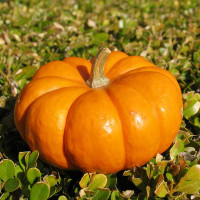Garland chrysanthemum / Chrysanthemum coronarium - is an annual plant. Gives a powerful fleshy strongly branching stem 1 m high. The leaves are dark green, repeatedly pinnate. The reed petals of the corolla are yellow, one or two-ton.
The plant is photophilous, drought-resistant. It grows well on light loams, prefers fertile soils.
The soil is dug up in autumn and compost is added at the rate of 4 kg per 1 m2. Seeds are sown in early spring (it is also possible in autumn) in rows every 30-40 cm. To obtain fresh greens, you can sow all summer until August.
Seeds are planted to a depth of 1.5-3 cm. As soon as the rows are indicated, in the cotyledon phase, the plants are thinned out, leaving 10-15 cm between them. The chrysanthemum is ready for harvesting 30-40 days after emergence.
Some plants can be left to seed. Seeds ripen 30-60 days after pollination of flowers, which are eagerly visited by bees and bumblebees.
Seed maturation period is long. When seed growing, chrysanthemum is best grown through seedlings. To do this, the seeds are sown a month before planting.
When the baskets turn yellow, they are selectively cut off, laid out in a dry, ventilated room. To obtain more seeds, plants can be cut at the root before frost, tied into small bunches and hung on trellises for ripening. Ripened seeds spill out well from the baskets.
Chrysanthemum flowers are very good in marinades. Before use, they can be soaked in vinegar with sugar. Part of the leaves can be dried for the winter in the shade. Adding dry leaves to soups and side dishes gives dishes a distinctive flavor.
Useful properties of vegetable chrysanthemum
Young leaves and flowers of the crowned chrysanthemum have a specific smell, pleasant taste and delicate aroma, they are eaten raw or boiled (while the greens retain all their beneficial properties). Freshly blossomed flowers decorate various dishes.
Petals of yellow inflorescences and young tender leaves are used for salads, and older leaves (they are tougher) are stewed and served as a side dish for meat or fish dishes. The stems of vegetable chrysanthemums can be boiled or fried. Fresh and dried leaves of vegetable chrysanthemum are valued precisely for their peculiar spicy taste and specific smell.
A special taste is given to the leaves of chrysanthemum by a marinade composed of apple cider vinegar with sugar, in which they are kept for some time. Some culinary enthusiasts use yellow chrysanthemum flowers to make desserts and wine, add chrysanthemum flowers and leaves to pickles.
Chrysanthemum vegetable also has medicinal properties
The plant contains salts of calcium, potassium, iron, phosphorus, useful trace elements, and is also very saturated with beta-carotene. There are reports that eating vegetable chrysanthemum helps prevent the formation of malignant tumors. Tinctures and decoctions from its leaves help in the treatment of migraines, and tinctures from dried inflorescences increase appetite.
Doctors recommend eating a salad of its petals and leaves more often for the prevention of cardiovascular diseases, and also as a mild laxative. But the most important thing, they believe, is the presence of bioantioxidants in the vegetable chrysanthemum, which increase the body's resistance to adverse environmental conditions, to cardiovascular and oncological diseases.
Common names include garland chrysanthemum, chrysanthemum greens, edible chrysanthemum, crowndaisy chrysanthemum, chop suey greens, crown daisy, and Japanese greens.

No questions about this product, be the first and ask your question.
























